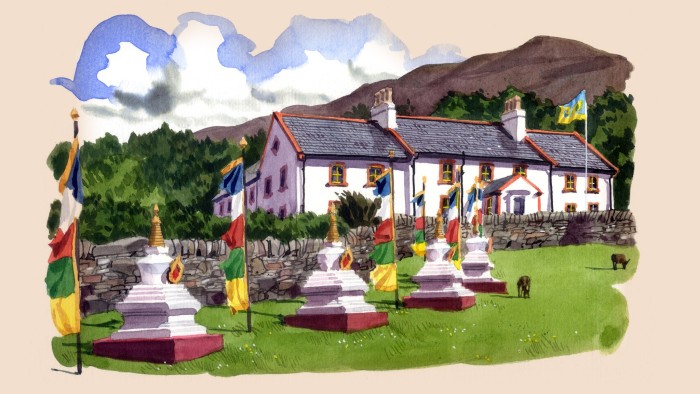Unlock the Editor’s Digest for free
Roula Khalaf, Editor of the FT, selects her favourite stories in this weekly newsletter.
Eight stupas greet us as we disembark from our ferry. Symbolic monuments to the life of the Buddha, they belong to the Kagyu tradition of Tibetan Buddhism, with brick-coloured square bases, white tapering steps and a golden spire. Prayer flags flutter close by. Neither are what you’d expect on a rugged island off the west coast of Scotland.
About 3km long, barely 1km wide, and with a heather-covered hill in the middle that leaves little space for flat ground, Holy Isle is a Buddhist retreat in the unlikeliest of settings. To get there from Glasgow, visitors take the train to Ardrossan, a large CalMac ferry across to the Isle of Arran, then a small boat across Lamlash bay to Holy Isle’s little jetty.
Arriving alongside me are Choden, a practising monk and university tutor originally from South Africa, and five students here for a teaching week as part of their MSc course in mindfulness run by Aberdeen university and the Mindfulness Association.
We are all here, so the story goes, because of a dream, or rather two. In the early 1980s, a Tibetan-born monk, Lama Yeshe Losal Rinpoche was practicing “dream yoga” while on a retreat in the US, when he saw an island “where human beings and all life forms could live in harmony”. In 1990, the monk was at Samye Ling, a Buddhist monastery on the Scottish mainland, when he was approached by Kay Morris, the owner of Holy Isle. A devout Catholic, she had apparently been visited by the Virgin Mary in a dream and instructed to pass the island to him. Initially dismissive, the Lama visited the island, recognised it from his own dream and set about a fundraising drive, eventually buying it for £350,000.
Walking around the island on a bright morning, the incongruity of Lama Yeshe’s vision is strikingly apparent. Starting in 1992, monks and volunteers began to transform its derelict cottages and farm buildings into the “Centre for World Peace and Health”. The old farmhouse on the north end of the island is now the retreat centre, reimagined in a muted Tibetan colour scheme that would not look out of place in Lhasa. Two wings extend to offer accommodation for up to 60 in simple rooms and dormitories, and there’s a meditation hall, library and kitchen garden, as well as solar-powered water heating and reed-bed sewage systems.

Aside from the monks, the island is maintained by a disparate cast of volunteers. Some are Buddhist — “Chenrezig” prayer is practised in a boathouse by the water early in the morning and after the evening meal — others appear to be here more for the relaxed pace of life and to be part of a communal project centred around sustainable living and wellbeing.
One volunteer, Izzy Brown, who lives in London and is the founder of start-up Yovo (a platform for volunteer recruitment and management), tells me she wanted a break after experiencing some tell-tale signs of burnout. Another, Timo Antero Raunela, a practising Buddhist and chef from Finland, soon handed me a copy of his prose poetry book, Snow and Rumours of Snow, inspired by his experiences on the island, where he has lived for eight years.
At dinner, Timo made us a wild garlic and nettle pesto pasta with salad, mostly sourced from the garden, and fruit salad with yoghurt for dessert. The mindfulness students, relieved from their meditation practice with Choden, came to join.


Over the following days I explored the island. On a walk up to the island’s peak, Mullach Mòr, I passed wild Eriskay ponies, goats and sheep as well as large boulders bearing paintings of Buddhist deities. On the island’s far southern tip I saw the women’s retreat — off limits to visitors — housed in renovated lighthouse keepers’ cottages and with an acre of garden. It is overlooked by two purpose-built cave-like retreat pods dug into the hillside (initially, 108 were envisioned, a sacred number in Buddhist tradition, but they were denied planning permission).
The three women there during my visit were one-year into a three-year closed retreat programme, guided by Drupon Rinpoche, a Kagyu Tibetan master from Nepal, over Zoom. “It can be very difficult — you are abandoning your social roles, your family, friends, and loved ones,” said Ani Palden, manager of the women’s retreat. “People can have a very positive experience if they come with the right attitude. If you come trying to be a yogini, you will not do well.”
Since its official opening in 2003, the centre has grown to offer a busy calendar of courses — in Buddhism, tai chi, yoga, meditation and more — as well as longer retreats and interfaith conferences, but day-tripping tourists are welcome to visit too. “We’re not a cult,” long-term volunteer Mike Phen told me, “but we spent a long time convincing residents on Arran of that.”
My few days on the island end with a freezing communal swim in the sea while waiting for the ferry, and a lasting impression of a community that thrives here against the odds.
Details
Alexander James was a guest of Visit Scotland (visitscotland.com). Accommodation on Holy Isle is only available to course participants, with a five-night stay costing £264 for a single room, full-board. Course fees range from £150 to £400; for details see holyisle.org.
To get to Holy Isle from Glasgow, take the train and ferry to Brodick on the Isle of Arran (about two hours in total, see calmac.co.uk), a short bus ride to Lamlash pier, then the 15-minute ferry to Holy Isle (see lamlashcruises.org.uk)
Find out about our latest stories first — follow FT Weekend on Instagram, Bluesky and X, and sign up to receive the FT Weekend newsletter every Saturday morning




